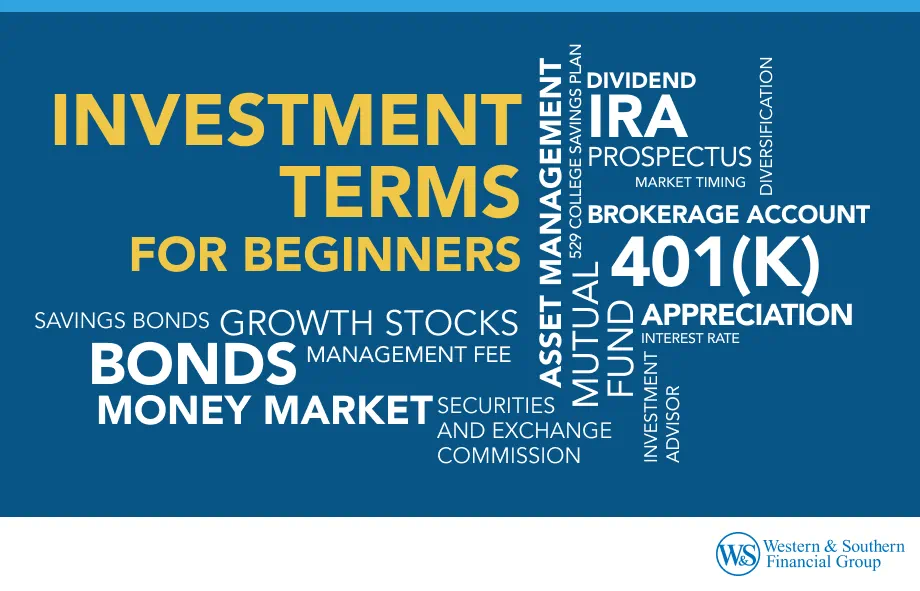Table of Contents
Table of Contents


A
Active Share
A measure that quantifies the extent to which a portfolio's holdings differ from its benchmark index. It is used to evaluate the level of active management employed by a portfolio manager.
Alpha
A measure of an investment's performance relative to a benchmark after adjusting for risk.
Annualized Rate of Return
The average rate of return on an investment per year over a specific period.
Annual Report
A yearly report by a company detailing its financial performance, strategy, and operations.
Annuities
Financial products that provide a regular stream of income for a specified period or life. They are commonly used for retirement planning.
Appreciation
An increase in the value of an investment over time.
Asset
Something of value that is owned or controlled by an individual or organization, such as stocks, bonds, real estate, or cash.
Asset Allocation
The distribution of investments across different asset classes, such as stocks, bonds, and cash.
Asset Bubble
A situation in which the prices of certain assets rise to unsustainable levels, often followed by a sharp decline.
Asset Class
A group of investments that share similar characteristics, such as stocks, bonds, real estate, or commodities.
Asset Management
The professional management of various investments on behalf of individuals or institutions to optimize returns.
B
Balanced Fund
A mutual fund that invests in a mix of stocks, bonds, and cash to achieve a balanced risk-return profile.
Bear Market
A market characterized by falling prices and pessimism.
Bearish
Pessimistic or negative sentiment about the future direction of the market or a particular investment.
Benchmark
A standard or index used to evaluate the performance of an investment or portfolio.
Beta
A measure of an investment's sensitivity to market movements, indicating its volatility relative to the overall market.
Bid Price/Ask Price
The bid price is the price at which a buyer is willing to purchase an investment, while the ask price is the price at which a seller is willing to sell it.
Blue-Chip Stocks
Shares of well-established, financially stable companies with a history of reliable performance.
Blue-Sky Laws
State regulations that aim to protect investors from fraudulent securities offerings.
Bond
A debt instrument issued by a government or corporation. As an investor, you can buy either a corporate bond or a government bond. The borrower must promise to repay the bond with interest by a specified maturity date.
Bond Fund
A mutual fund that invests in a diversified portfolio of bonds.
Book Value
The value of a company's assets minus its liabilities, often used as a measure of its net worth.
Brokerage Account
An investment account that allows individuals to buy and sell securities, such as stocks, bonds, and mutual funds, through a brokerage firm. It provides access to the financial markets and often offers various investment options and services.
Bull Market
A market characterized by rising prices and optimism.
Bullish
Optimistic or positive sentiment about the future direction of the market or a particular investment.
Buying Long
The act of purchasing an investment with the expectation that its price will rise over time, allowing for potential profit upon selling.
C
Capital
Financial assets or resources used for investment purposes.
Capitalization
The total value of a company's outstanding shares.
Capital Gain
The profit earned from selling an investment for a higher price than its purchase price.
Capital Loss
The loss incurred when selling an investment for a lower price than its purchase price.
Cash
Money in the form of physical currency or readily available funds held in a bank account or similar liquid assets.
Cash Equivalent
Highly liquid investments that are easily convertible to cash.
Certificate of Deposit (CD)
A time deposit offered by banks with a fixed term and a fixed interest rate. They are considered low-risk investments.
Common Stock
Shares representing ownership in a company, giving voting rights and potential dividends.
Compound Interest
Is the process of earning interest not only on the initial amount of money or principal but also on the accumulated interest from previous periods. In other words, it is interest that "compounds" over time.
Corporate Bond
A debt instrument issued by a corporation to raise capital.
Cyclical Stocks
Stocks of companies whose performance is closely tied to economic cycles, such as those in the automotive, construction, or travel sectors.
D
Day Trade
The buying and selling of a security within the same trading day with the intention of profiting from short-term price fluctuations.
Debt-to-Equity Ratio
A financial ratio that compares a company's total debt to its total equity, indicating its level of leverage.
Defensive Stocks
Stocks of companies that tend to perform relatively well during economic downturns due to their stable demand, such as those in the healthcare or consumer staples sectors.
Deflation
The general decrease in prices over time, often accompanied by a decrease in economic activity.
Derivative
A financial instrument whose value is derived from an underlying asset, such as options, futures, or swaps.
Diversification
Spreading investments across different assets to reduce risk.
Dividend
A portion of a company's profits distributed to shareholders.
Dividend Aristocrats
Companies that have a consistent track record of increasing dividends year after year.
Dividend Reinvestment Plan (DRIP)
A program that allows shareholders to automatically reinvest their dividends into additional shares of the company's stock.
Dividend Yield
The annual dividend payment relative to the stock's current price, expressed as a percentage.
Dollar Depreciation
A decrease in the value of a currency relative to other currencies.
Dollar Index
A measure of the value of the U.S. dollar relative to a basket of other currencies.
Dollar Value Averaging
Investing a variable amount of money at regular intervals to maintain a consistent dollar value of investments.
Dollar-Cost Averaging
Investing a fixed amount of money at regular intervals, regardless of market conditions.
Dollar-Wise Investing
Focusing on minimizing investment expenses, such as fees and commissions, to maximize returns.
Dow Jones Industrial Average (Dow)
An index that tracks the performance of 30 large, publicly traded companies.
E
Earnings Per Share (EPS)
A company's profit divided by its total number of outstanding shares, providing a measure of its profitability on a per-share basis.
Equity
Ownership interest in a company represented by shares of stock.
ETF (Exchange-Traded Fund)
Similar to a mutual fund, but it trades on an exchange like a stock.
Expense Ratio
The annual fee charged by a mutual fund or ETF to cover operating expenses.
Strengthen your future with investment options designed to build long-term growth. Invest In My Future
F
Federal Funds Rate
The interest rate at which banks lend reserve funds to each other overnight.
Federal Reserve Board (The Fed)
The central banking system of the United States responsible for monetary policy.
Fixed Annuity
An annuity that offers a guaranteed fixed rate of return for a specific period, providing a predictable stream of income.
Fixed Income Fund
A mutual fund that invests in bonds or other fixed-income securities.
Fixed Income Security
A debt instrument that pays a fixed interest or dividend over a specified period.
Forex
Short for foreign exchange, it refers to the global market for trading currencies, where participants buy, sell, and speculate on various currency pairs.
Fundamental Analysis
Evaluating a company's financial health, competitive position, and future prospects to determine its intrinsic value.
Futures Contract
A standardized agreement to buy or sell an asset at a predetermined price on a future date.
G
Growth Stocks
Stocks of companies that are expected to grow at an above-average rate compared to other companies.
Growth Investing
An investment strategy focused on selecting stocks with potential for above-average growth.
H
Hedge Fund
An investment fund that pools capital from accredited individuals or institutional investors to employ various strategies in the financial markets.
I
Immediate Annuity
An annuity that begins making regular payments immediately after the initial investment, typically used for retirement income.
Impact Investing
Investments made with the intention of generating positive social or environmental impact alongside financial returns.
Index Fund
A type of mutual fund that aims to replicate the performance of a specific market index, such as the S&P 500.
Indexed Annuities
Annuities with returns tied to the performance of a specific market index, offering potential growth with downside protection.
Inflation
The general increase in prices over time, which erodes the purchasing power of money.
Interest Rate
The cost of borrowing money or the return earned on an investment.
Intrinsic Value
The perceived or calculated value of an investment based on its fundamental characteristics and cash flows.
Interest-Rate Risk
The risk that changes in interest rates will affect the value of fixed-income securities.
Invest
To allocate funds with the expectation of generating income or profit over time, typically by purchasing assets such as stocks, bonds, or real estate.
Investment Advisor
A professional who provides guidance and recommendations on investments.
Investment Company
A firm that pools money from investors to invest in various securities.
Investment Objective
The specific financial goal or target of an investment strategy.
IPO (Initial Public Offering)
The first sale of a company's stock to the public, transitioning from private to public ownership.
IPO Lock-Up Period
A predetermined period following an initial public offering (IPO) during which company insiders are restricted from selling their shares.
IRA (Individual Retirement Account)
A retirement account that allows individuals to save for retirement with tax advantages. For 2023, the federal government limits IRA contributions to $6,500 per year if you're under age 50, and $7,500 per year if you're age 50 or older (because you can contribute up to $1,000 in catch-up contributions).
J
Junk Bond
A high-risk, high-yield bond issued by companies with lower credit ratings.
L
Large-Cap
Refers to companies with large market capitalization, usually considered more established and stable.
Leverage
The use of borrowed money to amplify potential returns or losses of an investment.
Lifecycle Funds
Mutual funds that automatically adjust their asset allocation over time, becoming more conservative as the target retirement date approaches.
Limit Order
An order to buy or sell an investment at a specific price or better.
Lipper Ratings
Performance ratings for mutual funds based on risk-adjusted returns.
Liquidity
The ease with which an investment can be bought or sold without causing significant price changes.
Liquidity Risk
The risk associated with the inability to buy or sell an investment quickly at a fair price.
Long-Term Investment Strategy
An approach focused on achieving goals over an extended period, typically years or decades.
M
Management Fee
The fee charged by an investment manager or mutual fund for managing the investments.
Margin Call
A demand by a broker for an investor to deposit additional funds or securities to meet the required margin level.
Margin Trading
Borrowing funds from a broker to buy securities, using the securities themselves as collateral.
Market Capitalization
The total value of a company's outstanding shares of stock, calculated by multiplying the stock price by the number of shares.
Market Order
An order to buy or sell an investment at the best available price.
Market Price
The current price at which an investment can be bought or sold in the market.
Market Risk
The potential for an investment's value to fluctuate due to overall market conditions.
Market Timing
Attempting to predict the future direction of markets to buy or sell investments at optimal times.
Maturity
The date at which a bond or fixed-income security becomes due for repayment.
Mid-Cap
Refers to companies with intermediate market capitalization, typically falling between large-cap and small-cap.
Money Market
A segment of the financial market where short-term, low-risk debt securities with high liquidity, such as Treasury bills and commercial paper, are traded.
Money Market Fund
A type of mutual fund that invests in short-term, low-risk securities, providing liquidity and stability while aiming for modest returns.
Morningstar Ratings
Ratings provided by Morningstar, a financial research company, to assess the historical performance and risk of mutual funds and stocks.
Municipal Bonds
Debt securities issued by state, local, or municipal governments to fund public projects. Interest earned from municipal bonds is typically exempt from federal income tax.
Mutual Fund
An investment vehicle that pools money from multiple investors to invest in a diversified portfolio of stocks, bonds, or other assets.
Mutual Fund Classes
Different variations of a mutual fund, often offering different fee structures and investment minimums to cater to different types of investors.
N
NASDAQ
A global electronic marketplace for buying and selling securities, primarily known for listing technology and growth-oriented companies.
Net Asset Value per share (NAV)
The value of a mutual fund's assets minus its liabilities, divided by the number of shares outstanding.
New York Stock Exchange (NYSE)
One of the world's largest stock exchanges located on Wall Street in New York City, where many large, well-known companies are listed and traded.
O
Options
Financial instruments that give the holder the right, but not the obligation, to buy or sell an asset at a predetermined price within a specific period.
P
Par Value
The nominal or face value of a bond or stock, which represents its original value at issuance.
P/B Ratio (Price-to-Book Ratio)
A valuation ratio that compares a company's stock price to its book value per share.
P/E Ratio (Price-to-Earnings Ratio)
A valuation ratio that compares a company's stock price to its earnings per share.
Portfolio Management
The process of overseeing and making decisions about a collection of investments to achieve specific financial goals.
Portfolio
A collection of investments owned by an individual or organization.
Portfolio Allocation
The distribution of investments across different asset classes or sectors to achieve diversification.
Prospectus
A legal document provided by an investment offering that contains important information for potential investors.
Proxy Voting
The process of delegating voting rights to another person or entity to vote on behalf of a shareholder at a company's shareholder meeting.
R
Real Estate
Property consisting of land and any structures or resources attached to it, such as buildings or natural resources.
Rebalancing
The process of adjusting the asset allocation of a portfolio to bring it back to its desired target mix, typically done periodically to maintain a desired risk level.
Recession
A significant decline in economic activity characterized by reduced production, employment, and income levels.
Redemption
The process of selling mutual fund shares back to the fund company.
Registered Investment Advisor (RIA)
A professional or firm that provides investment advice and is registered with the Securities and Exchange Commission (SEC) or state securities regulators.
REIT (Real Estate Investment Trust)
A company that owns, operates, or finances income-generating real estate, allowing investors to gain exposure to the real estate market.
Required Minimum Distributions (RMDs)
The minimum amount that individuals with certain retirement accounts, such as Traditional IRAs or employer-sponsored plans, must withdraw annually after reaching a specific age (usually 72).
Return on Investment (ROI)
The gain or loss generated on an investment relative to its cost.
Risk Management
The process of identifying, assessing, and mitigating potential risks to protect investment portfolios.
Risk Tolerance
An individual's ability to withstand investment losses or volatility.
Risk-Adjusted Return
The return on an investment adjusted for the level of risk taken.
Robo-Adviser
An online platform that uses algorithms and technology to provide automated investment advice and portfolio management based on individual financial goals and risk tolerance.
Rollover IRA
An individual retirement account created by transferring funds from a qualified retirement plan, such as a 401(k), without incurring taxes or penalties.
Roth IRA
An individual retirement account that allows individuals to make after-tax contributions, and withdrawals can be tax-free in retirement, subject to certain conditions.
S
Savings Bonds
Bonds issued by the government that offer a fixed interest rate and are considered low-risk investments suitable for saving money.
Sector
A specific segment of the economy or market, such as technology, healthcare, or financial services.
Securities
Financial instruments, such as stocks, bonds, or derivatives, that represent ownership or debt.
Securities and Exchange Commission (SEC)
A government agency responsible for regulating securities markets and protecting investors.
Share
A unit of ownership in a company, typically represented by a stock certificate or electronic entry.
Share Class
Different classes of shares within the same mutual fund, often with varying fees and benefits.
Sharpe Ratio
A measure of risk-adjusted return that evaluates an investment's return relative to its volatility.
Short Selling
The practice of selling borrowed securities in the hope of buying them back at a lower price to profit from a decline in their value.
Small-Cap
Refers to companies with relatively small market capitalization, often associated with higher growth potential and risk.
Standard & Poor's Index
A family of indices that measure the performance of different segments of the stock market, such as the S&P 500.
Standard Deviation
A statistical measure of the variability or dispersion of returns from an investment or portfolio.
Stock
A share of ownership in a company.
Stockholder
An individual or entity that owns shares of stock in a corporation.
Stock Split
A corporate action where a company divides its existing shares into multiple shares, thereby increasing the number of shares outstanding while reducing the price per share.
Stop-Loss Order
An order to sell an investment if it reaches a specified price to limit potential losses.
Sustainable Investing
An investment approach that considers environmental, social, and governance (ESG) factors alongside financial returns.
T
Target Date Fund
A mutual fund designed to automatically adjust its asset allocation based on a specific target retirement date, gradually becoming more conservative as the target date approaches.
Taxable Account
An investment account in which earnings and gains are subject to taxation.
Tax-Deferred Account
An investment account, such as an IRA or 401(k), in which earnings and gains are not taxed until withdrawn.
Technical Analysis
Analyzing past price and volume patterns of a security to predict future price movements.
Time Horizon
The intended length of time an investor plans to hold an investment to meet specific financial goals.
Total Return
The overall return from an investment, including dividends, interest, and capital appreciation or depreciation.
Traditional IRA
An individual retirement account where contributions may be tax-deductible, and investment earnings grow tax-deferred until withdrawals are made, typically in retirement.
Treasury Bill
Short-term debt issued by the government to raise funds, typically with a maturity of one year or less.
Treasury Bond
Long-term debt issued by the government with a maturity typically exceeding 10 years.
Treasury Note
Intermediate-term debt issued by the government with a maturity ranging from 2 to 10 years.
Treasury Security
A term encompassing Treasury bills, bonds, and notes issued by the U.S. government.
Turnover Ratio
A measure of the frequency with which investments within a portfolio are bought and sold over a given period.
V
Valuation
The process of determining the worth or fair value of an investment or asset.
Value Investing
An investment strategy focused on buying assets that are considered undervalued based on fundamental analysis.
Value Stocks
Stocks of companies that are considered undervalued by the market based on fundamental analysis.
Variable Annuities
Insurance contracts that offer a range of investment options. The value of variable annuities fluctuates based on the performance of the underlying investments.
Venture Capital
Funding provided by investors to early-stage companies with high growth potential in exchange for equity ownership.
Volatility
A measure of the price fluctuations of an investment over a specific period.
Volatility Index (VIX)
A measure of market volatility, often referred to as the "fear index."
Y
Yield
The income generated from an investment, usually expressed as a percentage.
Yield to Maturity
The total return anticipated on a bond if held until its maturity date, taking into account its current price, coupon payments, and time remaining.
Z
Zero Coupon Bond
A bond that is sold at a discount to its face value and does not pay periodic interest. Instead, the bond is redeemed for its full face value at maturity, representing the return on investment.
#
401(k)
A retirement savings plan sponsored by an employer, usually offering tax advantages.
403(b) Plan
A retirement savings plan offered to employees of public schools, tax-exempt organizations, and certain nonprofit organizations, allowing them to contribute to a retirement account on a pre-tax basis.
52 Week High
The highest price at which a security has traded in the past 52 weeks, providing an indication of its recent peak performance.
52 Week Low
The lowest price at which a security has traded in the past 52 weeks, providing an indication of its recent bottom performance.
529 College Savings Plan
A tax-advantaged investment account designed to help individuals save for future education expenses. Contributions to the plan grow on a tax-deferred basis, and withdrawals used for qualified educational expenses are tax-free.
Investments can create opportunities for financial growth, helping secure your long-term goals. Invest In My Future



















